Choosing the right mountain bike can feel overwhelming. With so many options available, from cross-country racers to downhill shredders, how do you find a Good Mtb Bike that fits your needs and riding style? This guide breaks down the best mountain bikes across different categories, helping you navigate the jargon and make an informed decision.
Specialized Stumpjumper 15 Comp: Top Overall Trail Bike
 specialized stumpjumper 15 comp
specialized stumpjumper 15 comp
OVERALL SCORE: 86
- Fun Factor: 9.0
- Downhill Performance: 9.0
- Climbing Performance: 8.0
- Ease of Maintenance: 8.0
Measured Weight: 32 lbs 9 oz (S4) | Rear Travel: 145mm
REASONS TO BUY:
- Adjustable headtube and bottom bracket height for customized geometry.
- Innovative SWAT box for on-bike storage.
- GENIE Shock technology enhances traction and linear feel.
REASONS TO AVOID:
- Incremental update rather than a revolutionary change from the previous Stumpjumper EVO.
- Overpowered rear brake for a trail bike.
- On the heavier side for a carbon trail bike.
The Specialized Stumpjumper 15 Comp represents refinement and evolution. While not a radical departure from its predecessor, this iteration boasts impressive upgrades. The FACT 11m carbon frame, offering 145mm of travel, adjustable geometry, and the practical SWAT box, is a testament to Specialized’s commitment to trail bike excellence. The GENIE shock is a standout feature, delivering a more linear initial stroke and improved traction, bridging the gap towards coil-like performance in an air shock. While Specialized highlights GENIE’s advantages with extensive data, it’s important to acknowledge it’s not a coil shock replacement. The Stumpjumper range is extensive, including coil shock and alloy frame options. The Comp model, the most affordable carbon version, features SRAM’s S1000 Transmission drivetrain, contributing to its performance but also its weight.
On the trail, the Stumpjumper 15 shines with its responsiveness and agility, especially in steeper geometry settings. Its confident and composed ride quality makes it versatile for various terrains, from bike parks to cross-country trails. The adjustable geometry, with a headtube angle as slack as 63.5 degrees and a low 330mm bottom bracket in its slackest setting, provides confidence on challenging descents. The updated front triangle enhances torsional rigidity, contributing to high-speed stability. The GENIE shock and a relatively steep seat tube angle (76.7 – 75.8 degrees) make it an efficient climber.
A minor drawback is the 203mm rear brake mount, paired with Maven Bronze brakes, which might be considered excessive for a trail bike, offering more rear braking power than typically needed.
Read more: Specialized Stumpjumper 15 Comp review
The Stumpjumper 15 excels as a versatile trail bike, earning its place as our top overall pick due to its balanced performance.
Credit: GearLab Staff
Ibis Ripmo V2 XT: Best Aggressive Trail Bike
OVERALL SCORE: 89
- Fun Factor: 9.0
- Downhill Performance: 9.0
- Climbing Performance: 9.0
- Ease of Maintenance: 7.0
Wheel Size: 29-inch | Rear Travel: 147mm
REASONS TO BUY:
- Exceptional all-around performance balance.
- Confident and stable descender.
- Efficient and capable climber.
REASONS TO AVOID:
- Not the lightest option in its class.
- Higher price point compared to some competitors.
The Ibis Ripmo V2 XT redefines aggressive trail bike performance, setting a new benchmark for the category. Its unparalleled combination of climbing and descending prowess is truly remarkable. This bike’s updated geometry, now slacker (64.9-degree head angle) and longer (1238mm wheelbase), along with refined suspension kinematics for increased end-stroke progressivity, elevates its descending capabilities. Already a confident descender, the Ripmo V2 now exhibits even greater composure on challenging terrain. Its high-speed stability and big-hit performance are unmatched. While the Santa Cruz Hightower is a strong contender, the Ripmo surpasses it in high-speed confidence and overall bravado. The Ripmo’s deep stroke compliance is exceptional, mirroring the Hightower’s strengths. Short 435mm chainstays contribute to the bike’s agile and sporty handling, allowing for quick direction changes and a lively feel. The DW-Link suspension platform, steep seat tube angle, and well-tuned kinematics result in exceptional climbing efficiency.
The Ripmo V2 truly embodies the “quiver killer” concept, excelling across a wide spectrum of trail conditions and riding styles. It’s an ideal choice for riders who prioritize both uphill and downhill performance without compromise. For riders seeking similar performance at a more accessible price, the aluminum-framed Ibis Ripmo AF NX is a worthy alternative.
Read more: Ibis Ripmo V2 XT review
 mountain bike – the ripmo v2 is super capable of handling technical climbs.
mountain bike – the ripmo v2 is super capable of handling technical climbs.
The Ripmo V2 excels in technical climbing situations.
Credit: Laura Casner
Revel Rascal XO Transmission: Best Mid-Travel Trail Bike
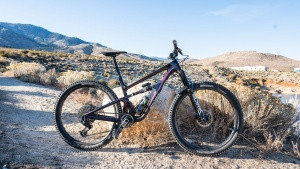 revel rascal xo transmission
revel rascal xo transmission
OVERALL SCORE: 88
- Fun Factor: 10.0
- Downhill Performance: 9.0
- Climbing Performance: 8.0
- Ease of Maintenance: 7.0
Wheel Size: 29-inch | Rear Travel: 130mm
REASONS TO BUY:
- Versatile and capable in diverse terrains.
- Sublime and efficient CBF suspension system.
- High-quality and durable wheels.
REASONS TO AVOID:
- Premium price tag.
- Non-adjustable geometry limits customization.
The Revel Rascal XO Transmission punches well above its weight class, delivering exceptional capability in a mid-travel package. Utilizing Canfield Brothers Formula suspension and advanced thermoset carbon technology, this bike offers a playful yet confidence-inspiring ride. Its geometry strikes a balance between modern trail bike standards and agile responsiveness, with 436mm rear center and 1222mm wheelbase. The Rascal exhibits phenomenal traction, whether climbing technical terrain or braking through challenging descents. Testers noted its similarities in ride quality to the Trek Top Fuel 9.8 GX AXS, highlighting its dialed geometry and kinematics. The suspension effectively isolates rider input, enhancing pedaling efficiency and control. The SRAM XO Transmission build, paired with Revel RW30 Carbon wheels and top-tier RockShox suspension, leaves little to be desired in terms of components.
While lacking frame storage and adjustable geometry, these omissions are easily overlooked given its exceptional performance. Although adjustable geometry can enhance versatility, the Rascal’s inherent versatility is undeniable. It excels on trails that push the limits of other mid-travel bikes, yet remains composed and enjoyable on mellower cross-country terrain. For performance-oriented riders seeking an uncompromising trail bike, the Rascal is a standout choice, justifying its premium price.
Read more: Revel Rascal XO Transmission review
The Rascal masterfully blends performance and style, making it a mischievously fun and capable trail companion.
Credit: Matt Lighthart
Yeti SB140 LR T2 TURQ: Best Technical Trail Bike
OVERALL SCORE: 86
- Fun Factor: 9.0
- Downhill Performance: 8.0
- Climbing Performance: 9.0
- Ease of Maintenance: 8.0
Wheel Size: 29-inch | Rear Travel: 140mm
REASONS TO BUY:
- Exceptional traction for technical climbs and descents.
- Precise and responsive handling.
- Fun and engaging on a wide range of trails.
REASONS TO AVOID:
- High cost.
- Non-adjustable geometry limits customization.
- No in-frame storage.
The Yeti SB140 LR T2 TURQ stands out as a top-tier mid-travel trail bike, offering a refined and efficient ride experience. This 140mm 29er delivers exceptional ride quality and performance that transcends its geometry numbers. Whether tackling steep climbs, fast flow trails, alpine epics, or jump lines, the SB140 rises to the occasion. Its climbing prowess is enhanced by excellent traction and near-ideal rider positioning, while long 440mm chainstays maintain rear wheel traction on technical climbs. Pointed downhill, the 65-degree head angle and supple suspension provide confidence and small bump sensitivity. The SB140’s balanced feel and precise tracking inspire confidence across diverse terrain. While capable in steep terrain, its speed limit is within reach, making it feel more refined than extreme, akin to off-roading in a Range Rover.
For riders prioritizing frame storage or adjustable geometry, the SB140 may not be the ideal choice. Similarly, more aggressive riders might seek longer-travel, slacker bikes. The Yeti SB140 prioritizes agility and athleticism over excessive travel and mass. Its exceptional traction empowers riders to push cornering and braking limits, making it a perfect companion for most North American singletrack.
Read more: Yeti SB140 LR T2 TURQ review
The SB140 is characterized by accuracy and adeptness, offering incredible capability despite not being the biggest or most extreme bike.
Credit: Abriah Wofford
Trek Top Fuel 9.8 GX AXS: Best Short Travel Trail Bike
 trek top fuel 9.8 gx axs
trek top fuel 9.8 gx axs
OVERALL SCORE: 83
- Fun Factor: 8.0
- Downhill Performance: 8.0
- Climbing Performance: 9.0
- Ease of Maintenance: 7.0
Measured Weight: 29 lbs 9 oz (large) | Rear Travel: 120mm
REASONS TO BUY:
- Mino-Link adjustable geometry and leverage rate.
- Integrated BITS bag for downtube storage.
- Compatible with 130/140mm suspension for increased travel.
- Mullet (MX) wheel compatibility.
REASONS TO AVOID:
- Heavier wheels than desired.
- Short saddle may not suit all riders.
The Trek Top Fuel 9.8 GX AXS represents the modern evolution of the “down-country” bike, blurring the lines between cross-country efficiency and trail capability. This 120mm OCLV carbon trail bike delivers surprising capability, excelling on climbs with its quick, responsive handling and efficient pedaling platform, rivaling dedicated XC bikes. The 76.3-degree seat tube angle optimizes pedaling power even on steep inclines.
Descending performance is enhanced by ABP suspension, which isolates braking forces from suspension action. A 65.9-degree headtube angle provides stability without compromising climbing agility. The 1227mm wheelbase further contributes to high-speed stability, exceeding expectations for a “short travel” bike. The Top Fuel exhibits flow, finesse, and true trail pedigree.
A versatile 4-way Mino-Link allows for geometry and leverage rate adjustments, and the frame is compatible with longer shocks and forks for increased travel (130/140mm). Wheel size options are plentiful, with larger models (M, ML, L, XL) featuring 29″ wheels and the S size utilizing 27.5″ wheels; larger sizes are also mullet compatible. Integrated frame storage via the Bontrager Bits system keeps essentials organized and rattle-free.
The Top Fuel is a well-rounded and adjustable trail bike that challenges the notion that trail bikes require excessive travel. Trek’s confidence in the bike is underscored by a 30-day Unconditional Guarantee.
Read more: Trek Top Fuel 9.8 GX AXS review
Despite its short travel designation, the Top Fuel is incredibly versatile and fun, proving that short travel doesn’t equate to short on fun.
Credit: Matt Lighthart
Ibis Ripmo AF NX Eagle: Best Trail Bike Under $3000
OVERALL SCORE: 80
- Fun Factor: 8.0
- Downhill Performance: 9.0
- Climbing Performance: 7.0
- Ease of Maintenance: 7.0
Wheel Size: 29-inch | Rear Travel: 147mm
REASONS TO BUY:
- Progressive and aggressive geometry for confident descending.
- Exceptional downhill performance.
- Surprisingly adept climber for its category.
REASONS TO AVOID:
- Heavy aluminum frame (“Heavy AF”).
- Sits at the upper end of the budget price range.
The Ibis Ripmo AF NX Eagle stands out as a budget-friendly brute, delivering impressive trail bike performance and climbing capability. Its 147mm of DW-Link travel and refined kinematics provide a bottomless feel without sacrificing pedaling efficiency. The Ripmo AF is lively, energetic, and playful, encouraging riders to push their limits. A 160mm fork and 64.9-degree headtube angle make it excel on steep descents. Despite its downhill focus, the 76-degree seat tube angle enables competent climbing, especially considering its 34lb weight. The Ripmo AF showcases how dialed geometry can enhance rider performance. Ibis has spec’d the bike with durable components, including robust suspension, wide rims, capable tires, and a reliable drivetrain. 4-piston brakes and a long dropper post further enhance its capabilities and rider confidence. The carbon Ripmo V2 shares the same platform but with lighter components and reduced weight.
The Ripmo AF’s main drawback is its weight, which can be noticeable on climbs and during prolonged rides. The suspension, while capable, lacks advanced valving for maximum pedaling efficiency. Its long travel might also be overkill for riders on mellower terrain. However, the Ripmo AF delivers exceptional capability and fun, representing outstanding value for the price.
Read more: Ibis Ripmo AF review
While not lightweight, the Ripmo AF “rips” on descents and offers incredible capability for under $3000.
Credit: Matt Lighthart
Canyon Neuron 5: Best Full-Suspension Bike Under $2000
 mountain bike
mountain bike
Wheel Size: 29″ | Weight: 33 lbs 10 oz (size large, set up tubeless)
REASONS TO BUY:
- Excellent climber.
- Outstanding value for a full-suspension bike.
- Geometry maintains fun at slower speeds.
REASONS TO AVOID:
- Best suited for moderate terrain.
- Less aggressive tires limit performance in technical conditions.
- Heavy for its travel category.
The Canyon Neuron 5 prioritizes cross-country roots in a trail bike package. Its 130mm of travel and slightly steeper geometry result in a snappy and responsive ride. The Neuron is most enjoyable on less challenging terrain, resisting the trend towards overly long and slack geometries. It’s optimized for riders who prefer less aggressive trails and prioritize climbing efficiency. Handling is crisp and responsive, making ascents and fire road climbs enjoyable.
However, the Neuron’s limitations become apparent in rougher terrain. Its responsive geometry can feel overwhelmed at higher speeds, and the 2.4-inch Schwalbe tires with efficient knobs reach their limit in loose or technical conditions. While capable of handling steep sections, it demands more rider skill and confidence in challenging situations. Despite its weight being less noticeable during general riding, it can feel heavy in technical maneuvers.
Read more: Canyon Neuron 5 review
The Neuron excels on moderate trails, offering a fun and engaging ride while remaining accessible.
Credit: Pat Donahue
Norco Fluid FS 4: Best Budget Mountain Bike
OVERALL SCORE: 81
- Fun Factor: 8.0
- Downhill Performance: 9.0
- Climbing Performance: 7.0
- Build: 8.0
Wheels: 29-inch | Rear Travel: 130mm
REASONS TO BUY:
- Highly competent in challenging terrain.
- Confident and stable at high speeds and on steep trails.
- Long-travel dropper post enhances descending capability.
REASONS TO AVOID:
- Heavy overall weight.
- Rear shock lacks a climb switch for improved climbing efficiency.
The Norco Fluid FS 4 earns our top pick for best budget mid-travel mountain bike, exceeding expectations for a “budget bike.” Its impressive on-trail performance quickly dispels any budget connotations. Whether tackling fast flow trails or technical descents, the Fluid FS 4 remains composed and delivers a fun and engaging ride. The stellar build kit, featuring a wide-range cassette and long-travel dropper post, further solidifies its position as best budget option.
Minor drawbacks include its weight, particularly noticeable in the extra-large test bike (over 36 pounds). Climbing performance is adequate, but a climb switch on the rear shock would improve efficiency on smoother terrain. Budget-conscious shoppers should also consider the Polygon Siskiu T8 as a strong competitor, offering balanced climbing and descending performance at a similar price point.
Read more: Norco Fluid FS 4 review
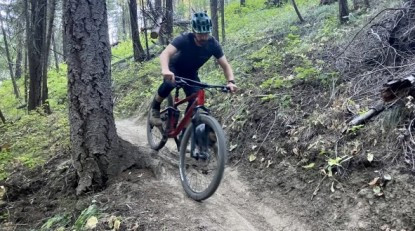 mountain bike – the fluid 4 fs was an incredibly competent descender.
mountain bike – the fluid 4 fs was an incredibly competent descender.
The Fluid 4 FS demonstrates impressive descending capabilities.
Credit: Pat Donahue
Specialized Turbo Levo Comp Alloy: Best Electric Mountain Bike
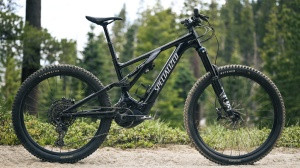 specialized turbo levo comp alloy
specialized turbo levo comp alloy
OVERALL SCORE: 87
- Downhill Performance: 9.0
- Climbing Performance: 8.0
- Measured Effective Range: 9.0
- Power Output: 9.0
- E-Bike Controls: 7.0
Wheel Size: MX (29″ front, 27.5″ rear) | Rear Travel: 150mm
REASONS TO BUY:
- Powerful motor for efficient assistance.
- Highly adjustable geometry for customized ride feel.
- Long-range 700Wh battery.
REASONS TO AVOID:
- Battery capacity no longer leads the market.
- Lower-end models lack a digital display.
- Stock tires could benefit from tougher casings.
Despite its last major update in 2022, the Specialized Turbo Levo Comp Alloy remains a dominant force in the e-MTB category. Mirroring the unpowered Stumpjumper, the Levo features highly adjustable geometry, allowing riders to fine-tune its character for diverse riding styles and terrains. Six distinct geometry settings offer versatility ranging from nimble trail bike to aggressive gravity slayer. This unprecedented adjustability sets it apart. With 150mm of FSR rear travel, a 160mm fork, and mixed wheel sizes, the Levo balances confident front-end stability with playful rear-end maneuverability. Specialized’s Turbo Full Power 2.2 motor delivers substantial power (90Nm torque, up to 565 peak watts) with three customizable support levels. A 700Wh battery provides ample range, and the overall system integration and balanced weight distribution contribute to a natural ride feel.
The Comp Alloy, a more affordable Turbo Levo build, offers functional components, but some areas could be improved. SRAM Code R brakes are not our top choice, and GRID TRAIL casing tires may be under-gunned for this bike’s weight and aggressive capabilities. While the 700Wh battery is solid, competitors are offering larger capacities, and range extender compatibility would be a welcome addition. Nevertheless, the Turbo Levo remains one of the best and most versatile electric mountain bikes, with its adjustable geometry being a key differentiator. For riders prioritizing maximum range, the Canyon Spectral:ON CF 8 with its 900Wh battery is a compelling alternative.
Read more: Specialized Turbo Levo Comp Alloy review
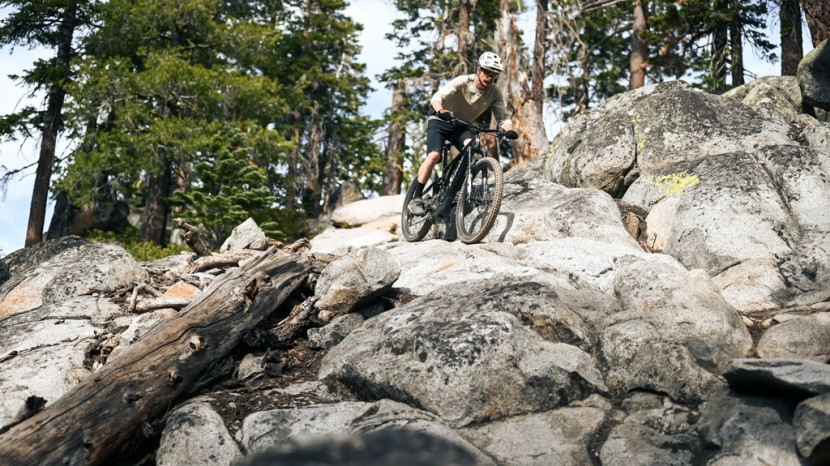 mountain bike – the turbo levo has been refined over the years, and its new…
mountain bike – the turbo levo has been refined over the years, and its new…
The Turbo Levo’s refined design and adjustable geometry enhance its versatility.
Credit: Abriah Wofford
Canyon Spectral:ON CF 8: Best Electric Mountain Bike for Range
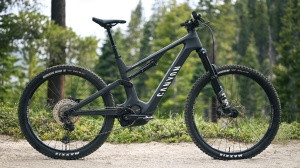 canyon spectral:on cf 8
canyon spectral:on cf 8
OVERALL SCORE: 85
- Downhill Performance: 8.0
- Climbing Performance: 8.0
- Measured Effective Range: 10.0
- Power Output: 8.0
- E-Bike Controls: 8.0
Wheel Size: MX (29″ front, 27.5″ rear) | Rear Travel: 155mm
REASONS TO BUY:
- Relatively affordable price point.
- Excellent component build for the price.
- Class-leading 900 Wh battery for exceptional range.
- Well-rounded trail riding performance.
REASONS TO AVOID:
- Motor/battery bulge reduces ground clearance.
- Non-e-bike specific fork.
- Rear tire could be more robust.
Canyon’s updated Spectral:ON models, exemplified by the Spectral:ON CF 8, offer a versatile trail e-MTB with exceptional value. This carbon-framed bike features mixed wheels (29″ front, 27.5″ rear), 150/155mm of travel, and modern trail geometry. Despite its 50+ pound weight, it handles well across varying speeds and terrains, exhibiting agility, stability, and composure. The popular Shimano EP8 motor delivers up to 85Nm of torque with customizable support modes. Its standout feature is the massive 900 Wh battery, providing the longest range among tested e-MTBs. Canyon’s direct-to-consumer model enables a high-value build for the price. While still a significant investment, the Spectral:ON CF 8 represents fantastic value in the e-MTB market. However, riders should also consider the Turbo Levo Comp Alloy, which offers a more powerful motor and adjustable geometry.
Read more: Canyon Spectral:ON CF 8 review
 mountain bike – the spectral:on cf 8 offers a well-rounded on-trail performance, a…
mountain bike – the spectral:on cf 8 offers a well-rounded on-trail performance, a…
The Spectral:ON CF 8 balances on-trail performance, a quality build, and a class-leading 900 Wh battery at a reasonable price.
Credit: Abriah Wofford
Fezzari Kings Peak Comp: Best Fat Bike
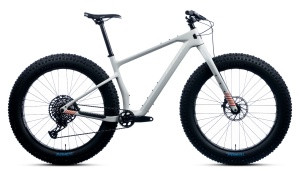 fezzari kings peak comp
fezzari kings peak comp
OVERALL SCORE: 81
- Downhill Performance: 8.0
- Uphill Performance: 8.0
- Versatility: 9.0
- Build: 7.0
Tire Size: 27.5×4.5-inch | Fork Travel: N/A
REASONS TO BUY:
- Reasonably priced for a fat bike.
- Modern trail bike inspired geometry.
- Abundant frame and fork mounting points for bikepacking.
REASONS TO AVOID:
- SRAM SX shifter ergonomics are less refined.
- Slip-on grips are a minor cost-cutting measure.
Fezzari, a consumer-direct brand, aims to make its mark with quality bikes like the Kings Peak Comp fat bike. Featuring geometry reminiscent of a trail bike, the Kings Peak offers a familiar feel on snow and dirt. Fezzari’s 23-point custom setup ensures a comfortable fit, and the geometry is well-suited for typical fat bike riding while maintaining surprising capability outside of typical fat bike terrain. A sleek carbon frame and a 31-pound weight contribute to efficient pedaling on diverse surfaces. Numerous frame and fork mounting points cater to bikepacking and adventure riding. The component build is functional and customizable, with Fezzari offering higher-spec builds and component upgrades.
Minor drawbacks include the SRAM SX shifter’s less ergonomic feel and the basic slip-on grips. Clarks M2 brakes offer adequate stopping power for fat bike speeds, but long-term durability is a question. Overall, the Kings Peak Comp is an excellent and recommended fat bike. For conditions not requiring fat tires and prioritizing all-around trail performance, the Ibis Ripmo V2 XT remains a top recommendation.
Read more: Fezzari Kings Peak Comp review
 mountain bike – the fezzari kings peak proved to be the best all-around fat bike…
mountain bike – the fezzari kings peak proved to be the best all-around fat bike…
The Fezzari Kings Peak stands out as the best all-around fat bike we’ve tested.
Credit: Jeremy Benson
How We Test the Best Mountain Bikes
Our mountain bike testing methodology focuses on rigorous hands-on evaluation of leading MTB bikes. Our experienced team pushes each bike to its limits across diverse terrains, including bike parks, epic all-day rides, long climbs, and challenging descents. Since 2017, we’ve consistently employed this demanding testing approach across trail, enduro, hardtail, fat, and electric mountain bikes, as well as budget-oriented models. Over seven years, we’ve invested over $200,000 in purchasing bikes at retail to maintain objectivity and unbiased reviews. When utilizing media or demo bikes, we ensure autonomy by paying demo or rental fees. Our commitment to unbiased, objective reviews aims to provide you with the most reliable mountain bike recommendations.
Why Trust GearLab
Our Senior Mountain Bike Review Editor, Joshua Hutchens, leads our expert test team. A lifelong mountain biker, coach, former racer, guide, and bike shop owner, Joshua possesses a deep understanding of bike performance and nuances. His extensive experience riding hundreds of mountain bikes allows him to discern subtle differences and provide insightful evaluations.
Joshua collaborates with a diverse team of professional bike testers, including former GearLab Mountain Bike Editor Pat Donahue, a talented rider with a preference for steep and technical descents, and Kyle Smaine, a multi-sport athlete and professional skier raised on iconic trails. This diverse testing team contributes to comprehensive and well-rounded bike reviews.
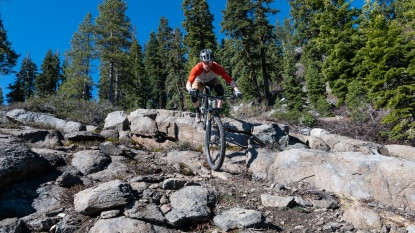 mountain bike – the ripmo v2 is one of our favorite bikes for a reason. there
mountain bike – the ripmo v2 is one of our favorite bikes for a reason. there
The Ripmo V2’s versatility and performance make it a tester favorite.
Credit: Laura Casner
How to Pick the Best Mountain Bike for You
Choosing a mountain bike is a significant investment that requires careful consideration. Understanding the different types of mountain bikes and their intended use is crucial. OutdoorGearLab simplifies this process, explaining mountain bike categories, wheel and tire size considerations, and women’s specific bike options.
Types of Mountain Bikes
Selecting the right mountain bike type depends on your local terrain and riding style. Consider the trails you typically ride and whether you frequent bike parks or trail centers.
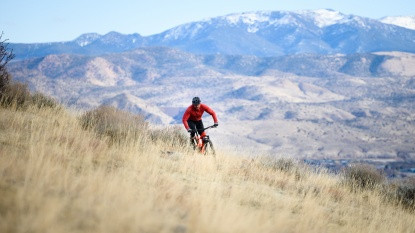 mountain bike – xc bikes are efficient rides for covering long distances and moving…
mountain bike – xc bikes are efficient rides for covering long distances and moving…
XC bikes prioritize efficiency and speed for cross-country riding.
Credit: Laura Casner
Cross-Country Bikes
Cross-country (XC) bikes are niche-focused, designed for racing and prioritizing weight and efficiency over all-around trail capability. Often hardtails or featuring around 100mm of rear suspension, XC bikes excel on smooth trails but are less versatile on technical terrain. Their stiff and efficient nature makes them suitable for racing but less ideal for playful trail riding. For most riders, a short-travel trail bike offers a better balance of efficiency and trail capability.
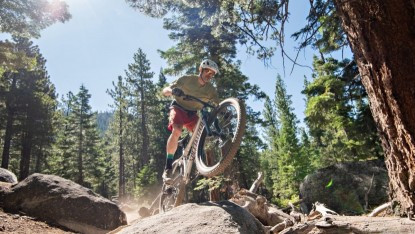 mountain bike – riding a bike is the only way to get to know its performance…
mountain bike – riding a bike is the only way to get to know its performance…
Hands-on riding is crucial for evaluating bike performance.
Credit: Jenna Ammerman
Trail Hardtails
Trail hardtail mountain bikes offer a simpler, lower-maintenance, and often more affordable option for trail riding. Lacking rear suspension, they prioritize pedaling efficiency and require more skillful line choices on descents. Hardtails are versatile but can be harsh on rough terrain. They are a great choice for budget-conscious riders and those who prioritize efficiency and simplicity.
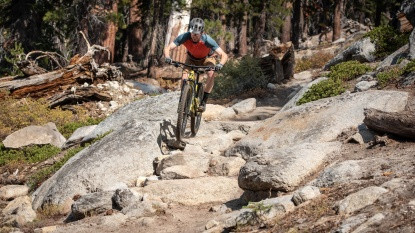 mountain bike – modern short-travel bikes can do it all, only limited by their…
mountain bike – modern short-travel bikes can do it all, only limited by their…
Short-travel trail bikes offer versatile performance for diverse trails.
Credit: Jenna Ammerman
Short-Travel Trail Bikes
Short-travel trail bikes, with approximately 110-130mm of rear travel, strike a balance between climbing efficiency and full-suspension comfort. Ideal for riders who value versatility and efficient climbing without aggressive descending focus. They are well-suited for flatter terrain or mountainous areas where aggressive descending isn’t the primary goal. For a more balanced climbing and descending experience, mid-travel bikes offer a step up in capability.
[Image of a mountain bike]
Mid-Travel Trail Bikes
Mid-travel bikes (130-150mm travel) represent a sweet spot for many mountain bikers, offering versatile performance for both climbing and descending. They balance climbing efficiency with descending capability, comfortable on diverse trails and occasional bike park visits. For primarily flat or smooth terrain, they might be overkill, while for extreme downhill riding, enduro/long-travel bikes are more specialized.
 mountain bike – enduro bikes are for riders who focus more on the descent than…
mountain bike – enduro bikes are for riders who focus more on the descent than…
Enduro bikes prioritize descending performance for technical trails.
Credit: Jenna Ammerman
Enduro Bikes
Enduro bikes, with 150-170mm of travel, are built for technical descents, prioritizing downhill performance over climbing efficiency. While pedalable, they are not ideal for long-distance rides or climbing-focused riding. Enduro bikes excel on rough downhills, freeride lines, and bike park laps.
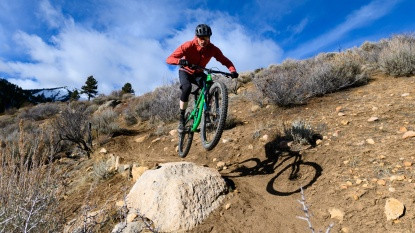 mountain bike – 26-inch wheels are a thing of the past, nearly all bikes have…
mountain bike – 26-inch wheels are a thing of the past, nearly all bikes have…
Modern mountain bikes predominantly use 27.5-inch or 29-inch wheels.
Credit: Laura Casner
Choosing Bike Components
Component choices further refine your mountain bike selection based on riding style and preferences.
Wheel Size
Mountain bike wheel sizes have evolved from 26-inch to primarily 27.5-inch and 29-inch. Larger wheels (29-inch) roll over obstacles more easily, maintain speed, and offer improved momentum. Smaller wheels (27.5-inch) can be more maneuverable. Mixed-wheel (“mullet”) setups combine a 29-inch front wheel for rollover and stability with a 27.5-inch rear wheel for agility. Wheel size choice can also consider rider height, with smaller riders potentially preferring smaller wheels and vice versa.
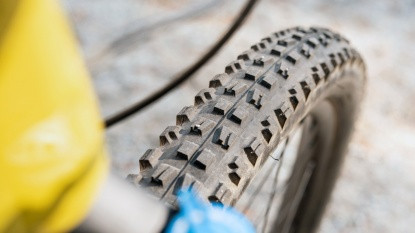 mountain bike – the right tires can make a huge difference in the performance of…
mountain bike – the right tires can make a huge difference in the performance of…
Tires significantly impact bike performance; Maxxis Minion DHF is a popular choice.
Credit: Jenna Ammerman
Tire Size and Rim Width
Tire widths have trended wider, with 2.4-2.5-inch being common on trail bikes, and wider rims accommodating 2.6-inch or plus-sized tires (2.8-3-inch). Wider tires offer increased traction and a softer ride but may increase rolling resistance. Rim width recommendations have also increased, with 28-35mm being a sweet spot for aggressive trail and enduro bikes, enhancing tire performance and traction.
 mountain bike – most bikes are offered in a range of build kits and prices.
mountain bike – most bikes are offered in a range of build kits and prices.
Mountain bikes are available in various build kits and price points.
Credit: Jenna Ammerman
Choosing a Complete Bike Build
- Frame: Aluminum frames are more affordable, while carbon fiber frames are lighter, stiffer, and offer better vibration damping. Carbon fiber ages better and is a worthwhile investment for long-term ownership.
- Fork and Rear Shock: Higher-end suspension components offer greater adjustability and performance. Coil-sprung suspension is often preferred for heavier riders.
- Drivetrain: 1x drivetrains (single front chainring) are simpler, lighter, and more user-friendly than 2x drivetrains. Most modern mountain bikes feature 1x drivetrains with 11 or 12 speeds.
- Wheelset: Rim width is crucial for tire performance. Wider rims enhance traction and comfort. Carbon fiber rims are lighter but more expensive than aluminum rims.
 mountain bike – most bikes come with 1x drivetrains that have a huge gear range.
mountain bike – most bikes come with 1x drivetrains that have a huge gear range.
1x drivetrains are prevalent on modern mountain bikes, offering wide gear ranges.
Credit: Jenna Ammerman
Women’s specific bikes often include tailored saddles, grips, and shock tunes.
Credit: Jenna Ammerman
Women’s Bikes
While most mountain bikes are unisex, women’s-specific models address fit and component considerations for female riders. Women’s bikes often feature smaller frame sizes, lighter shock tunes, women’s saddles, narrower handlebars, and shorter cranks. Frame size and appropriate shock tune are key aspects of women’s mountain bike design. Many manufacturers now offer lighter shock tunes on smaller frame sizes to better accommodate lighter riders.
 mountain bike – making bikes smaller with lighter shock tunes for smaller riders…
mountain bike – making bikes smaller with lighter shock tunes for smaller riders…
Frame size and shock tune are crucial for women’s mountain bike fit and performance.
Credit: Jenna Ammerman
 mountain bike – minimal assembly required. slap on the wheels and the handlebars…
mountain bike – minimal assembly required. slap on the wheels and the handlebars…
Consumer-direct bikes often require minimal assembly.
Credit: Jenna Ammerman
Consumer Direct vs. Local Bike Shop
Consumer-direct bike brands offer competitive pricing by selling directly to consumers, bypassing local bike shops. While offering cost savings and convenience, consumer-direct purchases may lack the support and services of a local bike shop, including assembly, repairs, warranty assistance, and expert advice. Local bike shops provide valuable services and expertise, building relationships with customers.
 mountain bike – more bikes mean more specific talents and more to maintain.
mountain bike – more bikes mean more specific talents and more to maintain.
Owning multiple bikes can cater to specific riding styles but increases maintenance.
Credit: Jenna Ammerman
Multiple Bikes?
A quiver of mountain bikes allows riders to optimize their bike choice for different terrain and riding styles. While a luxury, owning a short-travel and an enduro bike can cover a wide range of trails. Mid-travel trail bikes offer a versatile compromise for riders seeking a single bike to handle most conditions. Renting specialized bikes for occasional bike park trips can be a practical alternative to owning multiple bikes.
Related: How to Select the Right Mountain Bike
Trainers, Exercise Bikes, and the Off-Season
Indoor training options, including exercise bikes and bike trainers, provide alternatives for off-season training or when trail access is limited. Interactive exercise bikes and bike trainers offer engaging and effective indoor cycling experiences. Treadmills provide a non-cycling cross-training option.
 mountain bike – there are loads of great mountain bikes to choose from. get a bike…
mountain bike – there are loads of great mountain bikes to choose from. get a bike…
The best way to find a good MTB bike is to get out and ride!
Credit: Laura Casner
Conclusion
This guide aims to simplify your mountain bike buying decision. Realistically assess your skills, riding goals, and typical terrain to choose the right type of mountain bike. The reviewed bikes represent top-performing options in their respective categories. OutdoorGearLab continuously tests and reviews leading mountain bikes to keep this guide current and informative, helping you find your perfect good MTB bike.

 mountain bike
mountain bike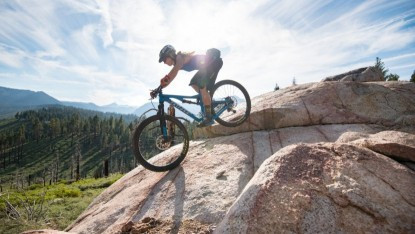 mountain bike – women
mountain bike – women